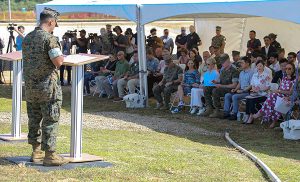Why Guam? Reactivation of Marine Corps Base Camp Blaz

U.S. Marine Corps Sgt. Donald Pangelinan, training non-commissioned officer for Marine Corps Base Camp Blaz, left, begins the ribbon cutting ceremony at the Sabånan Fadang Memorial on MCB Camp Blaz, Guam, Jan. 25, 2023. The Sabånan Fadang Burial Site is composed of seven grave sites that were preserved in place and contains multiple individuals from the Latte Period to the very early Post-Contact Period. The burial site also includes a reinterment crypt for fragmentary remains discovered in the area during construction, which are assessed to be part of the ancient Chamoru village of Sabånan Fadang.
(U.S. MARINE CORPS/LANCE CPL. GARRETT GILLESPIE)
The Marine Corps is reactivating a new base on Guam, Marine Corps Base Camp Blaz. Why Guam?
The governments of Japan and the United States have committed to developing training areas in Guam and the Commonwealth of the Northern Mariana Islands. With the help of a large monetary contribution from the government of Japan, the construction of MCB Camp Blaz plays an essential role in strengthening the Marine Corps’ posture in the Indo-Pacific region that is geographically distributed, operationally resilient and politically sustainable.
The U.S. territory holds immense Marine Corps history, dating back to the beginning of the 20th century. In 1901, Marine Barracks Guam was officially established in the Village of Sumay. During World War I, the first shots fired by Americans were done in Apra Harbor by U.S. Marines. On April 7, 1917, Marines from the barracks fired warning shots against German sailors from the interned ship, SMS Cormoran. This German ship, along with many other sunken artifacts, can still be seen off Naval Base Guam.
In World War II, Marine Barracks Guam was forced to surrender to Imperial Japanese Forces on Dec. 10, 1941. The Marines returned with a vengeance when the III Amphibious Corps landed to retake the island on July 21, 1944. The island was declared secure on Aug. 10, 1944, and the Marine Barracks were reactivated June 4, 1946, remaining an integral part of the U.S. presence on the island until it was deactivated on Nov. 10, 1992.
MCB Camp Blaz is named to honor the first indigenous Marine from the Marianas Islands, or CHamorro Marine, Brig. Gen. Vincent T. “Ben” Garrido Blaz. Gene. Blaz is a World War II survivor. He earned his commission in the Marine Corps and in 1977, he became the first CHamorro Marine to attain the rank of brigadier general. He later served Guam as a delegate to the House of Representatives for almost a decade.
MCB Camp Blaz is currently under construction and will be complete in the coming years.
By GUNNERY SGT. RUBIN TAN
Marine Corps Base Camp Blaz























